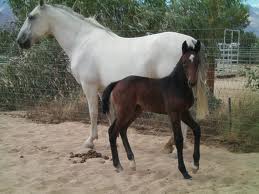|
Lipizzan
Lipizzan: The Lipizzan breed dates back to the 16th century, when it was developed with the support of the Habsburg nobility. The breed takes its name from one of the earliest stud farms established, located near the Kras village of Lipica(spelled "Lipizza" in Italian), in modern-day Slovenia. 
The earliest predecessors of the breed originated in the 7th century when Barb horses were brought into Spain by the Moors and crossed on native Spanish stock. The result was the Andalusian horse and other Iberian horse breeds. Four hundred years of selective breeding have made the this horse one of Europe’s oldest breeds.
In 1572 the first Spanish Riding Hall was built, during the Austrian Empire, and is the oldest of its kind in the world. The Spanish Riding School, though located in Vienna, Austria, takes its name from the original Spanish heritage of its horses. In 1729 Charles VI commissioned the building of the Winter Riding School in Vienna and in 1735, the building was completed that remains the home of the Spanish Riding School today.

Today, though found in many nations throughout Europe and North America, the breed is relatively rare, with only about 3,000 horses registered worldwide. The number of foals born each year is small, and breeders take extreme care to preserve the purity of the breed. Aside from the rare solid-colored horse (usually bay or black), most are gray. Like all gray horses, they have black skin, dark eyes, and as adult horses, a white hair coat. Gray horses, including Lipizzans, are born dark, usually bay or black and become lighter each year as the graying process takes place, with the process being complete at between 6 and 10 years of age. Contrary to popular belief, Lipizzans are not actually true white horses. A white horse is born white, has pink skin and often have blue eyes. Noted for his sturdy body and proud carriage, the Lipizzan’ head is remarkable for its large appealing eyes and small alert ears. The body presents a picture of strength with a crested neck, most horses measure between 14.2 and 15.2 hands. However, horses bred that are closer to the original carriage horse type are taller, approaching 16.1 hands.
|
 During World War II, the high command of Nazi Germany transferred most of Europe's Lipizzan breeding stock to Hostau, Czechoslovakia. The breeding stock was taken from Piber in 1942, and additional mares and foals from other European nations arrived in 1943. The stallions of the Spanish Riding School were evacuated to St. Martins, Austria from Vienna in January 1945, when bombing raids neared the city and the head of the Spanish Riding School, Colonel Alois Podhajsky, feared the horses were in danger of being destroyed. The intervention of American General George S. Patton during World War II. saved the horses. On May 12, American soldiers began riding, trucking and herding the horses 35 miles across the border into Kotztinz, Germany. The horses were eventually settled in temporary quarters in Wimsbach, until the breeding stock returned to Piber in 1952, and the stallions returned to the Spanish Riding School in 1955.
During World War II, the high command of Nazi Germany transferred most of Europe's Lipizzan breeding stock to Hostau, Czechoslovakia. The breeding stock was taken from Piber in 1942, and additional mares and foals from other European nations arrived in 1943. The stallions of the Spanish Riding School were evacuated to St. Martins, Austria from Vienna in January 1945, when bombing raids neared the city and the head of the Spanish Riding School, Colonel Alois Podhajsky, feared the horses were in danger of being destroyed. The intervention of American General George S. Patton during World War II. saved the horses. On May 12, American soldiers began riding, trucking and herding the horses 35 miles across the border into Kotztinz, Germany. The horses were eventually settled in temporary quarters in Wimsbach, until the breeding stock returned to Piber in 1952, and the stallions returned to the Spanish Riding School in 1955.
